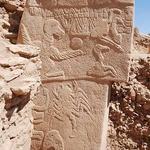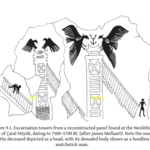igazából nem nagyon érdekel a kosárkád, viszont Göbekli Tepe mindenképpen figyelmet érdekel. itt újra előbukkan a menetrendszerű téveszméd:
"Az első kép bal alsó sarkában levő madár-ábrázolás a napkoronggal kifejezetten egyiptomi jellegzetességeket mutat:"
mindegy is, hogy mit értesz egyiptomi jellegzetességek alatt, már megint olyat látsz, ami senki szerint nincs ott. persze úgy nehéz megítélni egy ábrázolást, hogy csak a kép egyik fele látszik.
lássuk először a teljes képet, utána pedig a lehetséges magyarázatot:

<What is believed to be the world's oldest pictograph has been discovered at the 12,000-year-old archaeological site of Göbekli Tepe in the Anatolia Region of Turkey.
The scene on the obelisk shows a human head in a vulture wing with the rest of the body below – experts believe it is an image of a sky burial.
A sky burial involves leaving bodies of the dead outside for birds and other animals to come and eat. They still take place in the Chinese provinces of Tibet, Qinghai, and Inner Mongolia and in Mongolia, with those who practice it believing the dead person's soul will go into the sky.
According to Hurriyet Daily News, two obelisks were found opposite each other and were shaped like the letter T. They were surrounded by small round obelisks.
Müslüm Ercan, director of the Şanlıurfa Museum and head of the Göbekli Tepe excavation, told the website: "The scene on the obelisk unearthed in Göbekli Tepe could be construed as the first pictograph because it depicts an event thematically.
It depicts a human head in the wing of a vulture and a headless human body under the stela.>
http://www.ibtimes.co.uk/worlds-oldest-pictograph-discovered-gobekli-tepe-shows-decapitated-head-vulture-wing-1511137
<During the Neolithic, vultures began to be depicted in art, suggesting that they were becoming embedded in myths and religion (Russell and Düring 2006). Several human-like representations of vultures are preserved in depictions made by sedentary communities, for example at Göbekli Tepe, Turkey (~9000 BP), Çatalhöyük, Turkey (~7000 BP), and in caves such as Baja California, Mexico (~7500 BP) (Crosby 1998). Excavations at Çatalhöyük have recovered the skulls of vultures from the walls of buildings (Mellarrt 1966; Russell and McGowan 2002) and it has been proposed that some skeletal remains indicate secondary burials (Mellart 1967). Depictions on stones showing vultures hovering close to headless human figures suggest that the bodies of the dead could have been left exposed to the elements and their flesh consumed by vultures, as in the Zoroastrian tradition.>
http://www.tandfonline.com/doi/abs/10.1080/08927936.2015.1052279#.VkyNDHYvfIU
<Klaus Schmidt interprets this "ball" as a human head, and this is almost certainly what it is, for on the back of another vulture lower down the register is a headless, or soulless, figure, just like the examples found in association with the vultures and excarnation towers at Çatal Höyük. And we can be sure that the "ball" does indeed represent a human head as similar balls are seen in the prehistoric rock art of the region, where their context also makes it clear they represent human souls.>
http://www.andrewcollins.com/page/articles/Gobekli.htm
ez a motívum egyébként máshol is felbukkan, nem csak Göbekli Tepében:
<There are two other, nearly life-size limestone sculptures of human heads at Nevalı Çori. They belong to composite motifs reminiscent of the totem-poles of the Native Americans of the northwest coast. One head is placed in front of a large bird, probably a vulture (Hauptmann, Schmidt 2007.68 Kat.-Nr. 95), which seems to be holding the head in its claws.>
http://arheologija.ff.uni-lj.si/documenta/authors37/37_21.pdf
<We see this type of thing portrayal on the walls in 6,000-5,000 BC in Çatalhöyük [in modern-day western Turkey].">
<Bird symbolism at Çatalhöyük, for those familiar with the results of the 1960s excavations, is most likely to mean vultures. The paintings of Griffon Vultures (Gyps fulvus) pecking at headless corpses, and the heads of this same vulture mounted on walls with beaks protruding from plaster mounds interpreted by the excavator as breasts, make for some memorable images (Mellaart 1967:101, 126, 150, 166-168; Figures 14, 15, 47; Plates 28, 45-49).>
http://journals.cambridge.org/download.php?file=%2F1609_DD80975A54D349E3F4AACA58699271AD_journals__AQY_AQY77_297_S0003598X00092516a.pdf&cover=Y&code=d5532a7345aff3368a9e7b504bdd5319
<Predominant images include men with erect phalluses, hunting scenes, red images of the now extinctaurochs (wild cattle) and stags, and vultures swooping down on headless figures.>
https://en.wikipedia.org/wiki/%C3%87atalh%C3%B6y%C3%BCk

<Bodily dismemberment—particularly decapitation—appears in the iconography and mortuary practicesof many ancient societies. A powerful and complex cultural statement, archaeologists working in the prehistoric Levant and contiguous regions of the Near East have explored decapitation in some depth.Very little research, however, has focused on the notion of headlessness and decapitation throughoutthe rest of the prehistoric Mediterranean. Some limited examples appear in the artistic traditions andburial practices of Anatolia and Greece; Anatolian wall paintings depict headless individuals, Neolithicburials in both regions produce skulls placed in specially designated locations, and select figurines appearto be designed with detachable heads. This paper gathers together some of the disparate information onheadless bodies and bodiless heads from Anatolia and Greece, and offers preliminary conclusions onthe range of their possible functions and meanings.>
http://www.academia.edu/556095/Heady_Business_Skulls_Heads_and_Decaptitation_in_Neolithic_Anatolia_and_Greece
a biztonság kedvéért nem csak tudományos, hanem ismeretterjesztő, sőt, horribile dictu alternatív forrásokat is megadtam.
egyik sem beszél napkorongról, vagy istenekről, kosárkáról meg pláne nem, de nyilván ők tévednek...